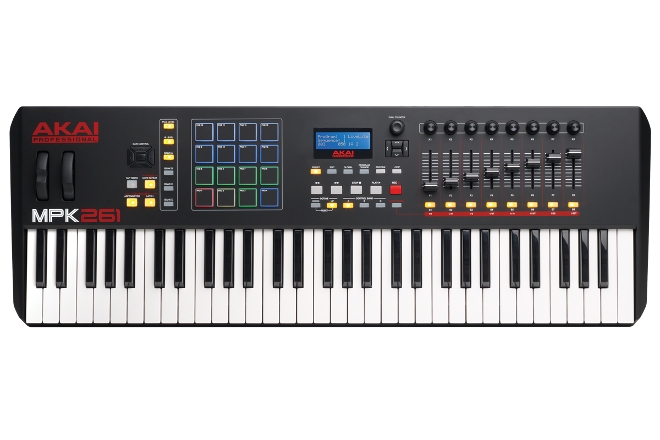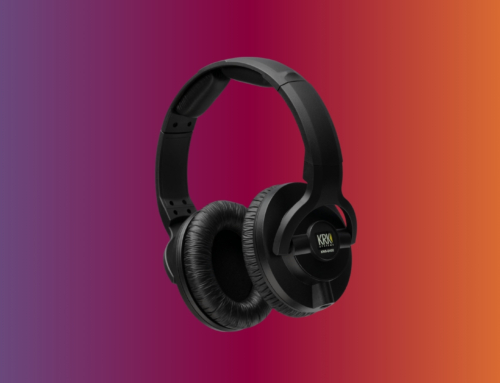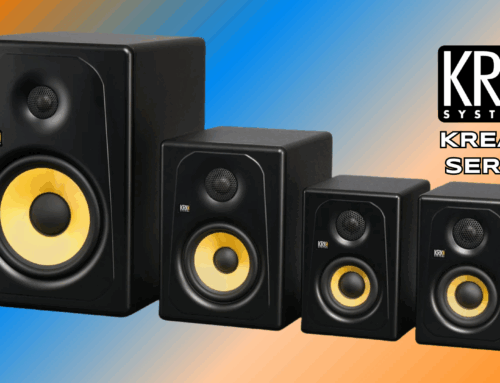For many years, the Akai MPK series of keyboards has been one of the most well-known and trusted options for affordable, quality MIDI controllers to help studio musicians unlock the full potential of their virtual instruments and production software. The MPK 225, 249, and 261 are three new offerings for 2014 which provide subtle but necessary and helpful updates to keep the venerable series relevant in today’s production market.
The MPK 261 is the true workhorse of the new MPK line, with the most comprehensive list of features. For a keyboard without a sound engine, it’s also a bit heavy at 15 lbs, but for a studio installation this isn’t a big issue. The MPK 261 has everything you’ve come to expect from an MPK: 8 knobs, faders, and switches for DAW and VST control, an LCD screen for navigating presets, transport controls, pitch and mod wheels, and 16 drum-pads, now in RGB LED flavor. Of course, this controller also features a spread of 61 semi-weighted keys, light enough to pass as synth-action and substantial enough to impart some satisfaction when pretending your MPK is a piano. As you may expect, these keys are velocity sensitive, pressure sensitive, and aftertouch-enabled. Having played with MPKs in 25-key, 49-key, and 61-key varieties, I can say that the full 61-key experience is a real treat, and does a great job of getting those creative juices flowing. For basslines and simple melodic pieces, the smaller boards will do just fine (and at significantly lower cost, too), but if you plan on playing more complex piano pieces or zone-mapping your keyboard for different instruments, the 261 is really the way to go.

Though much of the power of the MPK comes from software, there is plenty of on-board goodness to talk about as well. For instance, the upgraded drum pads are a significant improvement from the original pads, which some users found less responsive than they would have liked. This time around, the pads much more closely approximate those found on Akai’s famous MPC line, with a great deal of sensitivity and resolution to allow for full expression of ideas. Also similar to an MPC, the pads come equipped with features like swing and roll, as well as an arpeggiator (for keys as well as pads). The MPK 261 is loaded with 4 pad banks as well as 3 knob/fader/switch banks for flexibility of control. Finally, as any studio keyboard should, the MPK features expression and sustain pedal inputs, as well as 5-pin MIDI in and out.
Besides the hardware, the MPK 261 also comes bundled with over $400 of software and virtual instruments to kick-start or expand your computer-based productions. One of the most beautiful and substantial softwares included is SONiVOX Eighty Eight 2.0, a lush array of grand piano samples that sound just like the real thing. Also included are AIR Hybrid 3 and SONiVOX Twist 2.0, two fresh new synths, as well as Akai’s MPC Essentials software and Ableton Live Lite, for some rhythm-making and idea-generating action.

Though the MPK 200-series may seem like a simple refreshing and repackaging of old hardware, the subtle improvements made to Akai’s famous line of keyboards are absolutely worthwhile, and at no additional cost – the new line retails for the same price as the old keyboards. Users will find the improvements to the drum pads wholly satisfying, and the bundled software, particularly the instruments, provides one more compelling reason to spring for the upgraded MPK when you’re looking to give your studio a boost.




